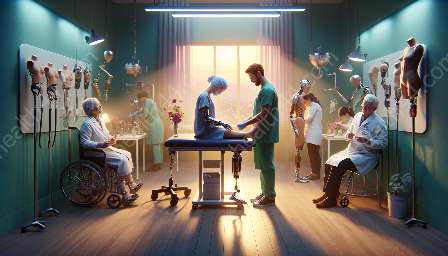Medical imaging equipment, such as x-ray machines, plays a crucial role in diagnostics and treatment planning in the healthcare industry. These technologies have revolutionized the way healthcare professionals diagnose and manage various medical conditions. In this topic cluster, we will explore the advancements in medical imaging equipment, its compatibility with prosthetic devices, and its synergy with other medical devices and equipment.
Medical Imaging Equipment: Advancing Healthcare
Medical imaging equipment encompasses a variety of technologies used to visualize the internal structures and functions of the human body. X-ray machines, in particular, have been instrumental in non-invasively capturing images of bones, organs, and tissues, aiding in the early detection and diagnosis of medical conditions.
With continuous innovations, medical imaging equipment has become more precise, efficient, and accessible, allowing healthcare providers to offer accurate diagnoses and personalized treatment plans. From traditional x-ray machines to advanced computed tomography (CT) and magnetic resonance imaging (MRI) systems, these technologies have significantly improved patient care and outcomes.
Compatibility with Prosthetic Devices
Prosthetic devices are essential in restoring mobility and function for individuals who have undergone limb amputations or have congenital limb deficiencies. Medical imaging equipment, particularly x-ray machines, plays a crucial role in prosthetics by providing detailed insights into the residual limb and its interaction with the prosthetic device.
Through the use of x-rays, healthcare professionals can assess the bone structure, joint alignment, and soft tissue integrity, ensuring a precise and tailored fitting of prosthetic limbs. Additionally, advanced imaging technologies aid in the development of custom 3D-printed prosthetics, enhancing comfort and functionality for prosthetic users.
Synergy with Other Medical Devices and Equipment
Medical imaging equipment integrates seamlessly with various other medical devices and equipment to deliver comprehensive healthcare solutions. For example, the interoperability of imaging systems with surgical navigation tools allows for precise guidance during surgical procedures, leading to improved surgical outcomes and reduced risks.
Furthermore, medical imaging equipment plays a pivotal role in the development and evaluation of medical devices such as implantable orthopedic hardware and advanced prosthetic components. The synergy between these technologies fosters interdisciplinary collaborations and drives continuous advancements in the field of medical technology.
Future Innovations and Impact on Healthcare
The future of medical imaging equipment holds promise for further advancements in diagnostic accuracy, imaging speed, and patient comfort. Integration of artificial intelligence (AI) and machine learning algorithms into imaging systems is expected to streamline image analysis, enabling early detection of diseases and abnormalities.
Moreover, the intersection of medical imaging equipment with prosthetic devices and other medical devices will continue to drive innovation in personalized healthcare, rehabilitation, and assistive technologies. As technology and healthcare converge, the potential for transformative impact on patient care and quality of life is immense.
Conclusion
Medical imaging equipment, including x-ray machines, serves as a cornerstone of modern healthcare, providing invaluable insights for diagnosis, treatment, and rehabilitation. The compatibility of these technologies with prosthetic devices and their integration with other medical devices and equipment exemplifies the collaborative nature of advancements in healthcare technology.
As research and development propel the medical imaging field forward, the synergies and interconnections with prosthetic devices and medical equipment are poised to shape the future of healthcare, ultimately benefiting patients and healthcare providers alike.


